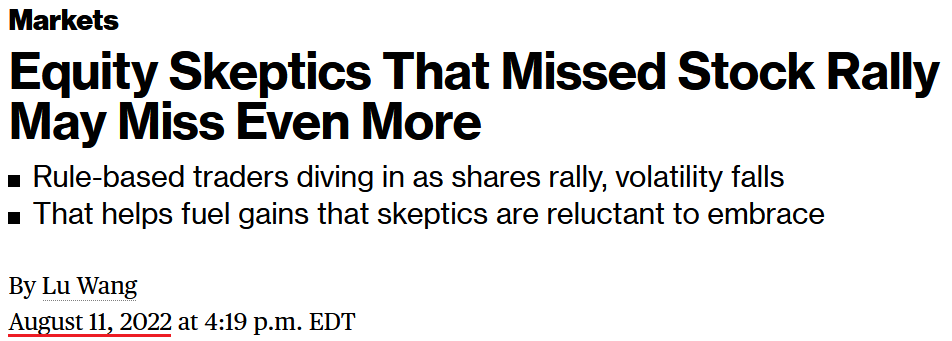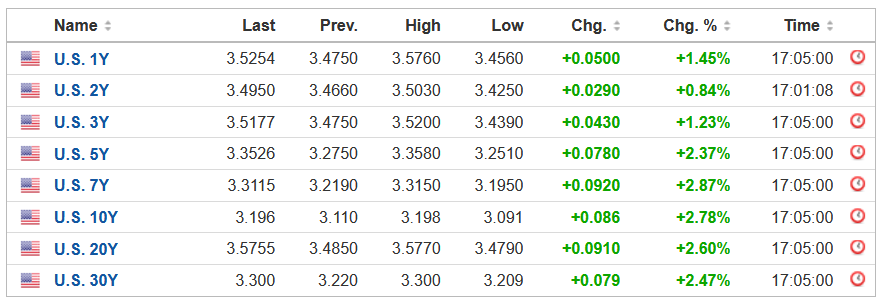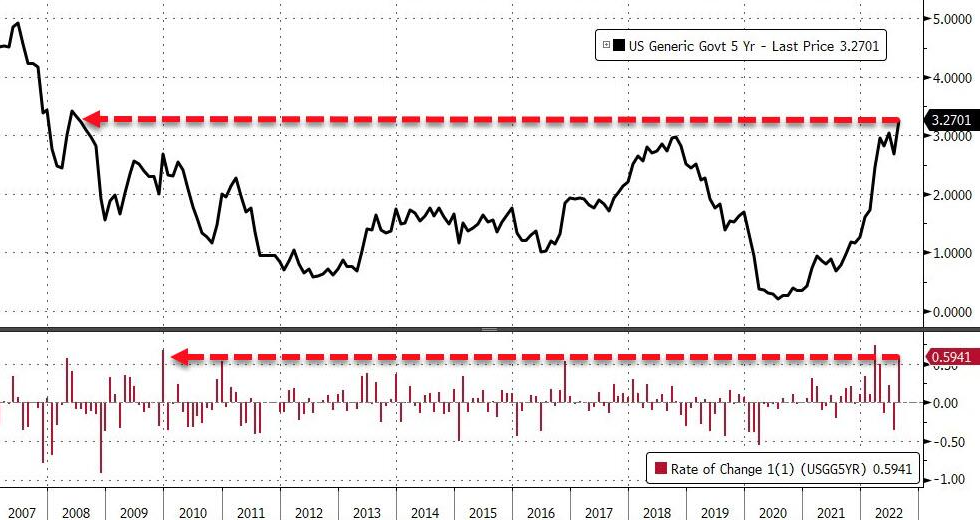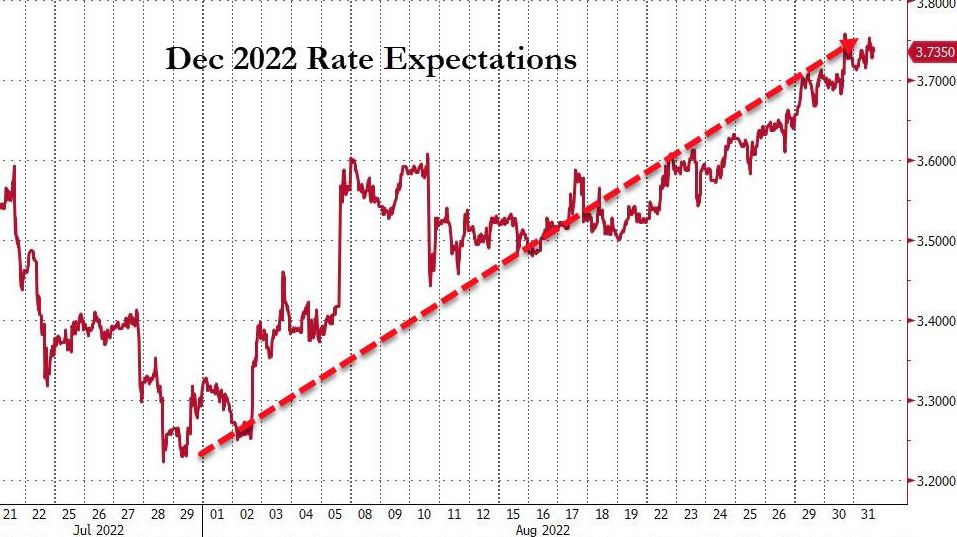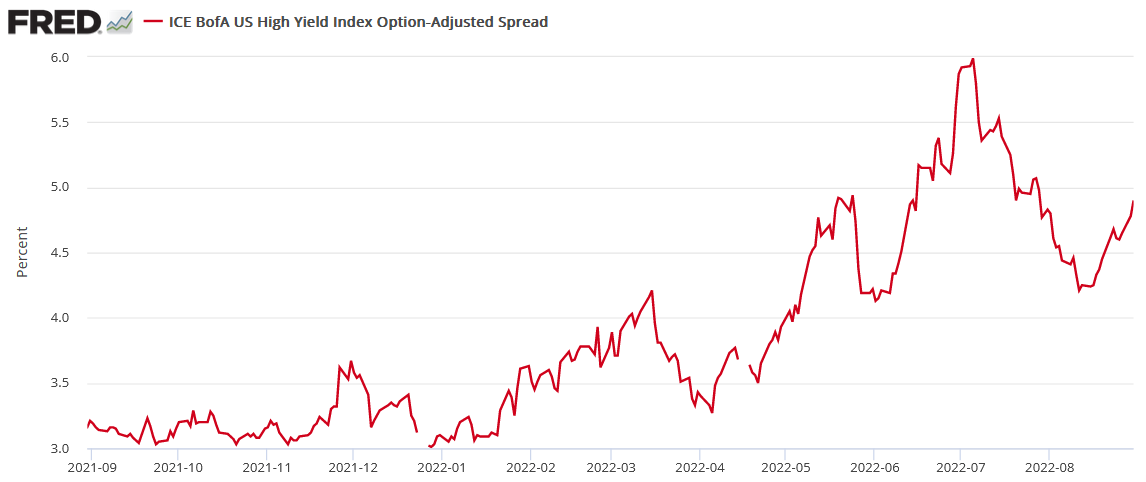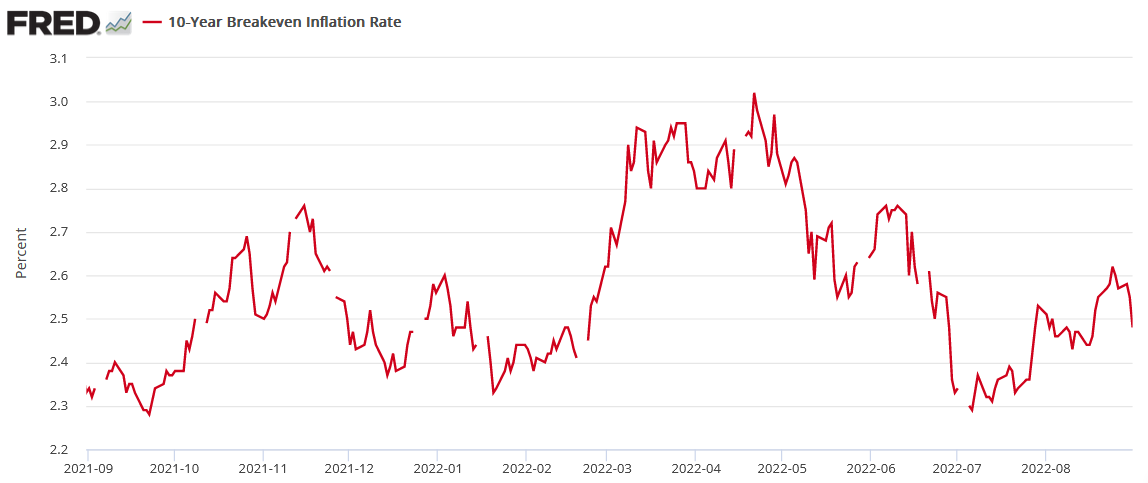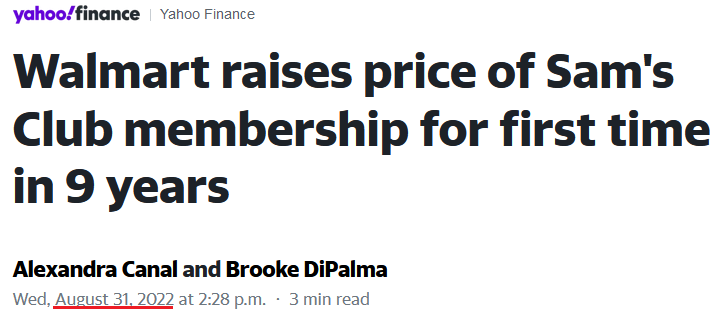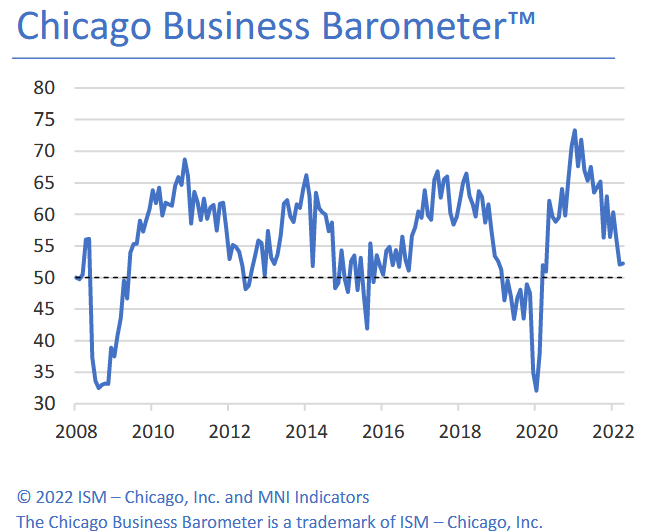Gold Miners Avoided Volatility, But More Downside Lies Ahead
Don't be fooled by the green color on the junior miners' chart. A momentary gleam is unlikely to make much difference in the medium term.
While the GDXJ ETF closed near the flat line on Aug. 31, the S&P 500 suffered another daily sell-off and closed at lows. Moreover, with the bulls celebrating a victory before the battle was even won, I warned on Aug. 12 that the bear market was far from over. I wrote:
With FOMO seeping into the mindsets of hedge funds and long-only managers, you better get on board before you “miss even more.”
Please see below:
Source: Bloomberg
(…) While the consensus and the media want you to believe that the bear market is over, their lack of fundamental objectivity highlights why narratives are so destructive. Remember, if normalizing inflation and reducing its balance sheet were so easy, the Fed would have done it already.
Think about it: the Fed was so cautious about tapering its asset purchases that officials waited until inflation was so unanchored that it couldn’t be ignored. But now, the Fed will hike interest rates to 3.4%, sell $95 billion in bonds per month and increase the U.S. unemployment rate to 3.7% (the Fed’s 2022 SEP projections) while the S&P 500 hits new highs? All the while, reducing the YoY headline CPI to 2%, even though it’s never been done since 1954 without the FFR coming within ~50 basis points of the cycle peak. Good luck.
Thus, with reality reasserting itself and the financial markets now heeding Fed members' hawkish warnings, U.S. Treasury yields rose on Aug. 30 and have risen sharply in recent days.
Please see below:
Source: Investing.com
To that point, the U.S. 5-Year Treasury yield hit its highest level since 2008, and its monthly rate of change (ROC) in August was the largest since 2009.
Please see below:
Source: Bloomberg/ZeroHedge
To explain, the black line at the top tracks the U.S. 5-Year Treasury yield, while the red line at the bottom tracks the monthly ROC. As you can see, both rallied materially in August, which was profoundly bearish for gold, silver, mining stocks, and the S&P 500.
In addition, with rate hike expectations rising sharply as well, hawkish realities have rattled the bulls.
Please see below:
Source: Bloomberg/ZeroHedge
To explain, the red line above tracks the number of rate hikes priced in for December 2022. If you analyze the clear uptrend, you can see that futures traders went from expecting a ~3.35% U.S. federal funds rate (FFR) to expecting a ~3.74% FFR by the end of the year. As such, the easing of financial conditions reversed in August, and the bulls are now on their back foot.
As further evidence, the ICE-Bank of America U.S. High Yield Option-Adjusted Spread (OAS) rose to 4.90% on Aug. 30 and has rallied nearly 70 basis points off the recent lows.
Please see below:
On top of that, the U.S. 10-Year breakeven inflation rate declined to 2.48% on Aug. 31; and with the U.S. 10-Year Treasury yield closing at 3.15%, a little math tells us the U.S. 10-Year real yield increased to 0.67%.
Please see below:
Moreover, I warned on Jan. 12 that higher real interest rates would upend the PMs. I wrote:
[Like] hyper-growth NASDAQ stocks and speculative assets like cryptocurrencies, PMs suffer from a similar fundamental affliction. For context, the PMs are less volatile than speculative assets. However, it's important to remember that gold, silver, and mining stocks peaked amid the liquidity-fueled surge in the summer of 2020. Likewise, their uprisings coincided with real interest rates that were at all-time lows at the time.
Conversely, with the Fed's liquidity drain already unfolding and real interest rates poised to rise in the coming months, the PMs should suffer from the likely re-pricings.
Thus, while the USD Index has been a reliable performer in 2022, the metrics above didn’t pull their weight in July. However, with material reversals occurring in August, the PMs have encountered heavy fundamental resistance.
Moreover, with the technicals painting a similar portrait, the PMs’ medium-term outlooks are profoundly bearish. As a result, while the GDXJ ETF managed to sidestep the volatility on Aug. 31, more downside should confront the junior miners in the months ahead.
Four Is a Crowd
While narratives about rampant inflation lured unsuspecting investors into precious metals long positions, I warned that the “the Fed is trapped” crowd was fighting a losing battle. I wrote:
The narrative implies that the Fed can’t tighten monetary policy without crashing the U.S. economy. Thus, Fed officials are “trapped,” and the PMs should soar as inflation runs wild. However, this hyper-inflationist theory is much more semblance than substance.
To explain, adopters assumed that the Fed couldn’t taper its asset purchases without crashing the U.S. economy. However, the Fed tapered, then accelerated the taper, and the U.S. economy remained resilient. Now, the new narrative is that the Fed can’t raise interest rates without crashing the U.S. economy. However, it’s simply misleading.
Furthermore, with nine rate hikes realized in 2022, the hyperinflationists suffered the same fate as the “transitory” promoters. Moreover, with Cleveland Fed President Loretta Mester the fourth official to echo my warning about the 1970s and 1980s, their message couldn’t be clearer.
Please see below:
Source: CNBC
She added:
“My current view is that it will be necessary to move the fed funds rate up to somewhat above 4% by early next year and hold it there. I do not anticipate the Fed cutting the fed funds rate target next year (…). Even if the economy were to go into a recession, we have to get inflation down.”
Therefore, while her mention of an FFR “somewhat above 4% by early next year” aligns with our way of thinking, the financial markets are still pricing in rate cuts. As a result, the expectations gap leaves room for more hawkish re-pricings in the months ahead.
Peak Nothing
While the headline Consumer Price Index (CPI) should decelerate somewhat when the data is released on Sept. 13, the consensus materially underestimates how difficult it will be to normalize the metric to 2%. Moreover, with Eurozone inflation exceeding expectations on Aug. 31, the data highlights why the pricing pressures pose a major challenge to global central banks.
Please see below:
Source: Investing.com
In addition, it’s important to remember that the U.S. is not immune to what unfolds in Europe. For example, roughly 30% of S&P 500 companies’ earnings are generated overseas, so weakness in foreign markets could heavily impact U.S. stocks, and, therefore, the PMs.
Furthermore, Sam’s Club – a warehouse retailer owned by Walmart – raised its annual membership fees for the first time in nearly a decade on Aug. 31. The higher prices take effect on Oct. 17 and will jump from $45 to $50 for club members and from $100 to $110 for “Plus” members. As a result, the 10% to 11% price increases are another example of U.S. companies protecting their profit margins.
Please see below:
Source: Yahoo Finance
Finally, the ISM released its Chicago Business Barometer on Aug. 31. The headline index increased from 52.1 in July to 52.2 in August.
Please see below:
Moreover, the report revealed that “prices paid held firm in August, all but unchanged at 81.8, with price pressures remaining acute.” In addition, “employment edged down 1.5 points to 54.6, implying little change in the tightness of the labor market.”
Thus, with both indexes remaining relatively uplifted, the U.S. labor market and inflation are slowing at a snail’s pace. Therefore, the Fed will have to continue its hawkish crusade in order to normalize wage and output inflation.
The Bottom Line
With the technical and fundamental outlooks unfolding exactly as expected, our GDXJ ETF short position has paid handsomely in 2022. However, asset prices don’t move in a straight line, and counter-trend rallies will likely occur during the GDXJ ETF’s medium-term drawdown. Yet, with the junior miners making lower closing and/or intraday lows throughout their 2021 and 2022 journeys, similar outcomes should materialize in the months ahead. As such, a final sell-off should confront the PMs before long-term buying opportunities emerge.
In conclusion, the PMs were mixed on Aug. 31, as the GDXJ ETF ended the day in the green. However, with the Fed hawked up, real yields rising, and the USD Index poised to make higher highs, the fundamental and technical environments do not support higher precious metals prices.
More By This Author:
Gold Is Poised To Move As The Euro Is Now Cheaper Than The USDPowell’s Words Can’t Shape Gold’s Medium-Term Fundamentals
If Investors Revive After Jackson Hole, Will The GDXJ Rise?
Disclaimer: All essays, research and information found on the Website represent the analyses and opinions of Mr. Radomski and Sunshine Profits' associates only. As such, it may prove wrong ...
more
